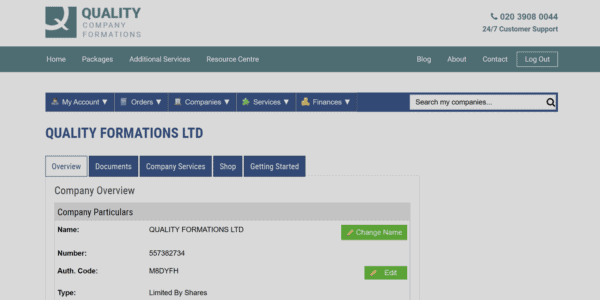You’d be forgiven for thinking that company formation is a long, drawn-out process that requires stacks of paperwork and plenty of back and forth. However, this couldn’t be further from the truth. At QCF, you can set up a limited company in 4 easy steps.
Key takeaways
- Choose a unique company name that complies with Companies House regulations to avoid registration issues.
- Select an appropriate formation package based on your business needs and desired level of service inclusivity.
- Provide accurate director and shareholder information to ensure a smooth application process and avoid delays.
In this article, we are going to take you through the steps for forming a limited company (a private company limited by shares – the most popular type of company). Let’s get started.
Step 1: Company name
All companies need a name. The first step of setting up a limited company with QCF is choosing yours. However, before you jump in and pick a name, there are a few things to be aware of:
- The name must be unique, as Companies House does not allow duplicate (or even similar) names to exist on the register at the same time
- The name should not be offensive
- If the name includes any ‘sensitive words or expressions’ (such as King, for example), you will require written permission from a relevant government body to accompany your formation request
- The name must end with ‘Limited’ or ‘Ltd’ (or the Welsh equivalents, Cyfyngedig and Cyf)
When you have thought of an appropriate name for your company, run it through our company name checker. We’ll immediately let you know if it’s available or not, and if it includes any sensitive words or expressions. If it is available, fantastic – you can proceed. If not, have a think and come up with another.
See here for further guidance on picking a suitable company name: 7 tips for choosing a company name
Step 2: Choose a company formation package
We offer 6 packages focused on registering a private company limited by shares:
- Basic, £51.99
- Privacy, £53.99
- Fully Inclusive, £59.99
- Non-Residents, £69.99
- Multiple Share, £69.99
All of these packages will provide limited company registration; however, some packages come with more inclusive products and services than others.
For example, the Basic Package provides you with limited company registration with minimal extras, whereas the Privacy Package allows you to use our Covent Garden address as your company’s registered office address and your director’s service address – ideal for keeping your residential address from appearing on Companies House public record.
- Why would my company formation application be rejected?
- Keep your home address off the public record at Companies House
- What does limited liability mean?
Further to this, if you want a fully comprehensive service that includes the majority of our core services – including the Full Company Secretary, VAT Registration and Business Address services – the Fully Inclusive Package would be appropriate.
Find out more about our company formation packages.
Step 3: Checkout and pay
After you have selected your package, you will be given the chance to add some additional services to your order, such as the Guaranteed Same Day Service (if you’re in a hurry to start trading) or the ICO Registration Service (most limited companies are required to register with the Information Commissioner’s Office).
When you are ready to proceed, you simply need to provide your email address, password, and your billing information. You can then make payment through most payment cards, such as Visa, Mastercard, and American Express.
Step 4: Complete details
Now it’s time to provide the key information about your company and opt-in to some of our exclusive partner offers. Whilst this is the most in-depth step of the process, provided that you have all the necessary details on hand, it shouldn’t take any longer than 15 minutes to complete.
Below is a summary of the information that you need to provide:
SIC Code
A Standard Industrial Classification (SIC) Code is a 5-digit number that describes a specific business activity. When setting up a company, you must select at least one SIC Code (you can choose up to four) from the list that we provide you.
Registered Office Address
The registered office address is your company’s official address. It must be a physical postal address, either commercial or residential, but you cannot use a PO Box. The use of our London Registered Office Address Service is included in a number of our packages. It can also be purchased separately for a new or existing company.
If your package does not include this service, you must provide a UK-based address to use as your registered office. Because the registered office address is placed on the public register, the use of a home address – whilst permitted – is not recommended.
Director information
This is the person (or people) tasked with the general day-to-day running of the company. A private company limited by shares needs at least one director (a company can be formed by just one person taking on all the necessary appointments/roles). For every director in the company, you must provide:
- Title
- Full name
- Date of birth
- Nationality
- Occupation
- Residential address (not placed on the public register)
You will also need to provide a service address for your directors (and shareholders and people with significant control). This is similar to the registered office address but for the individual rather than the company. The address is on the public register, so using a residential address is not recommended.
Several of our company formation packages include the option to use our address as the service address. If your package does not include this, you will need to provide an address that you have permission to use (we will, however, give you the option to purchase our Service Address again as an additional extra).
Shareholder information
This is the person (or people) who own the company. A private company limited by shares needs at least one shareholder. The shareholder(s) may be the same person(s) as the director(s), but there is no requirement for this. For every shareholder in the company, you must provide:
- Title
- Full name
- Date of birth
- Nationality
- Occupation
- The answer to 3 security questions (for example, mother’s maiden name, father’s forename, town of birth)
- Residential address (not placed on the public register)
- Service address (placed on the public register, a number of our packages allow you to use our address)
Share information
At the same time as naming the shareholder(s) in your company, you must also give information about the shares they are going to own. For each shareholder, you must provide:
- The number of shares they will hold
- The currency of the shares
- The price per share
- Any particulars associated with the shares (if you wish to deviate from the default particulars that we provide)
The number of shares you allocate defines the ownership structure of the company.
For example, if you have two shareholders and want them to have a 50/50 share split, you could allocate them with 1 share each. Alternatively, if you want a 75/25 split, you could allocate 3 shares to one shareholder and 1 to the other.
Shareholders are liable for the unpaid nominal value of the shares they own – this means if the company were to encounter financial difficulties, this is the amount that they could lose. Because of this, we recommend allocating a low number of shares at this stage.
Person with significant control (PSC) information
This is the person (or people) who ultimately control the company. In most cases, this will also be a shareholder. Generally, a private company limited by shares needs at least one PSC. For every PSC in the company, you must provide:
- Title
- Full name
- Date of birth
- Nationality
- Occupation
- Residential address (not placed on the public register)
- Service address (placed on the public register, a number of our packages allow you to use our address)
Also, when naming your PSC(s) you will be provided with a list of ‘Nature of control’ options regarding:
- The ownership of the shares in the company
- Voting rights attached to these shares
- Whether or not the PSC has the power to remove directors
- If there’s any other form of significant interest or control
All you need to do is choose the options that apply to your company/PSC and answer some basic ‘yes’ or ‘no’ questions.
Articles of association
The articles of association outline how the company is going to be operated. You do not have to do anything regarding this, as your application will automatically be accompanied by the default articles of association.
Some of our company formation packages – including the Multiple Share Class Package include the option to use your own articles of association. If you have purchased one of these packages, you can upload your document during the company formation process.
Choose your ‘Business Essentials’
We have partnered up with several business service providers to give you some exclusive offers to get your business off to the best start. The final step of the registration process, before reviewing your application, is to opt-in to any offers that appeal to you.
You can select from a range of business bank account providers, accounting software solutions, and other partners. Plus, you also have another chance to pick up any additional services that we offer, such as VAT registration, PAYE registration, and more.
Once your company has been formed, you will be sent further information on how to redeem any offers that you selected.
That’s everything you need to set up a limited company
All that’s left for you to do is review the information that you have provided, ensuring that there are no mistakes. When you are ready, you can submit the application, which will then be sent to Companies House by our team of company experts.
As soon as your company application has been approved at Companies House, we will email your company information and documentation (such as company number, certificate of incorporation, and share certificates). This typically takes up to 24 hours. You do not need to let HMRC know about your new company, as they will be automatically notified about its incorporation.
So there you have it
That’s how you can set up a company online in 4 easy steps with Quality Company Formations.
Ready to get started? Check if your company name is available now (step 1). We hope you have found this article useful. Please leave a comment if you have any questions about this post or setting up a company in general, and we’ll get back to you as soon as possible. Thanks for reading.














Join The Discussion